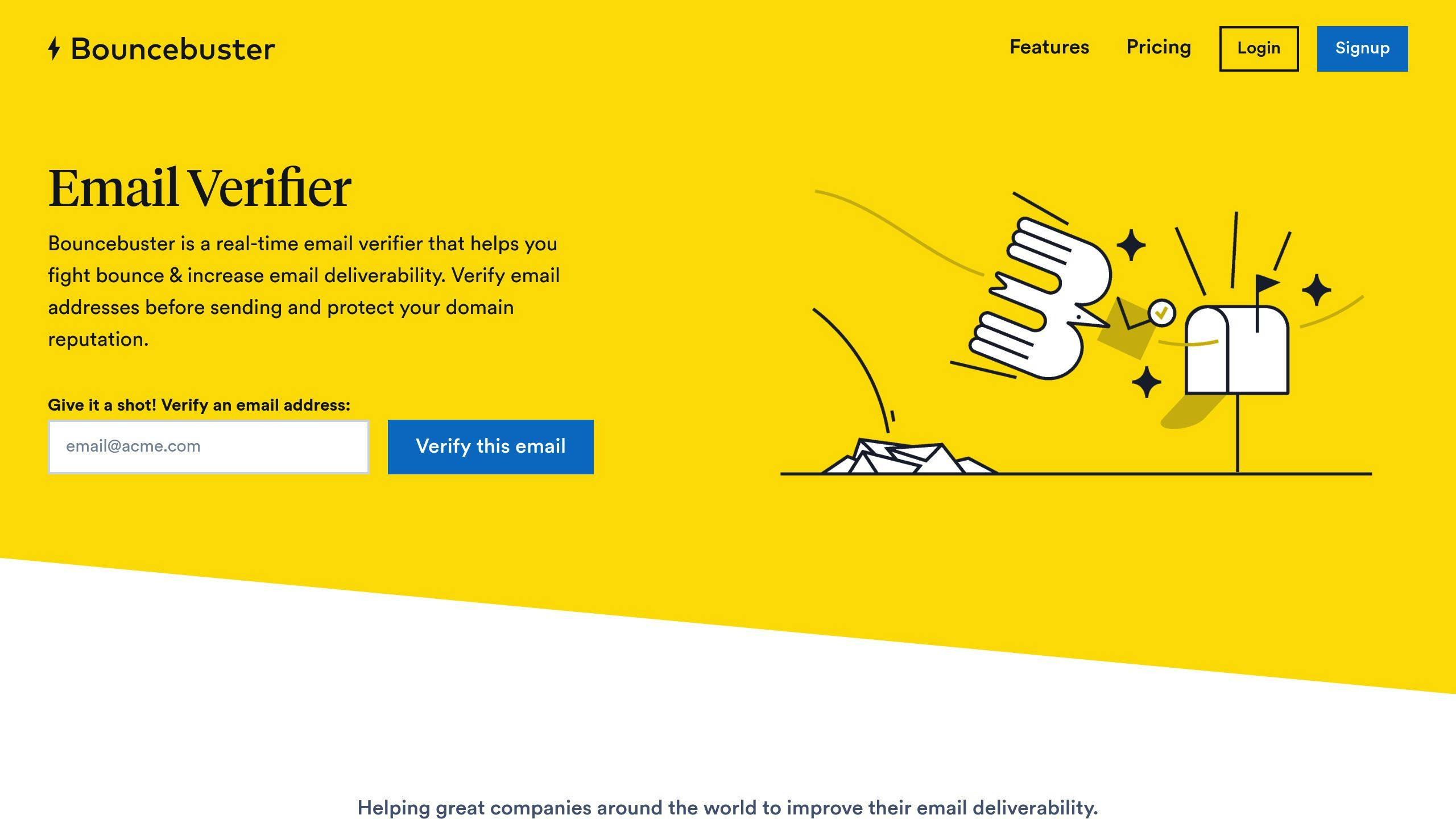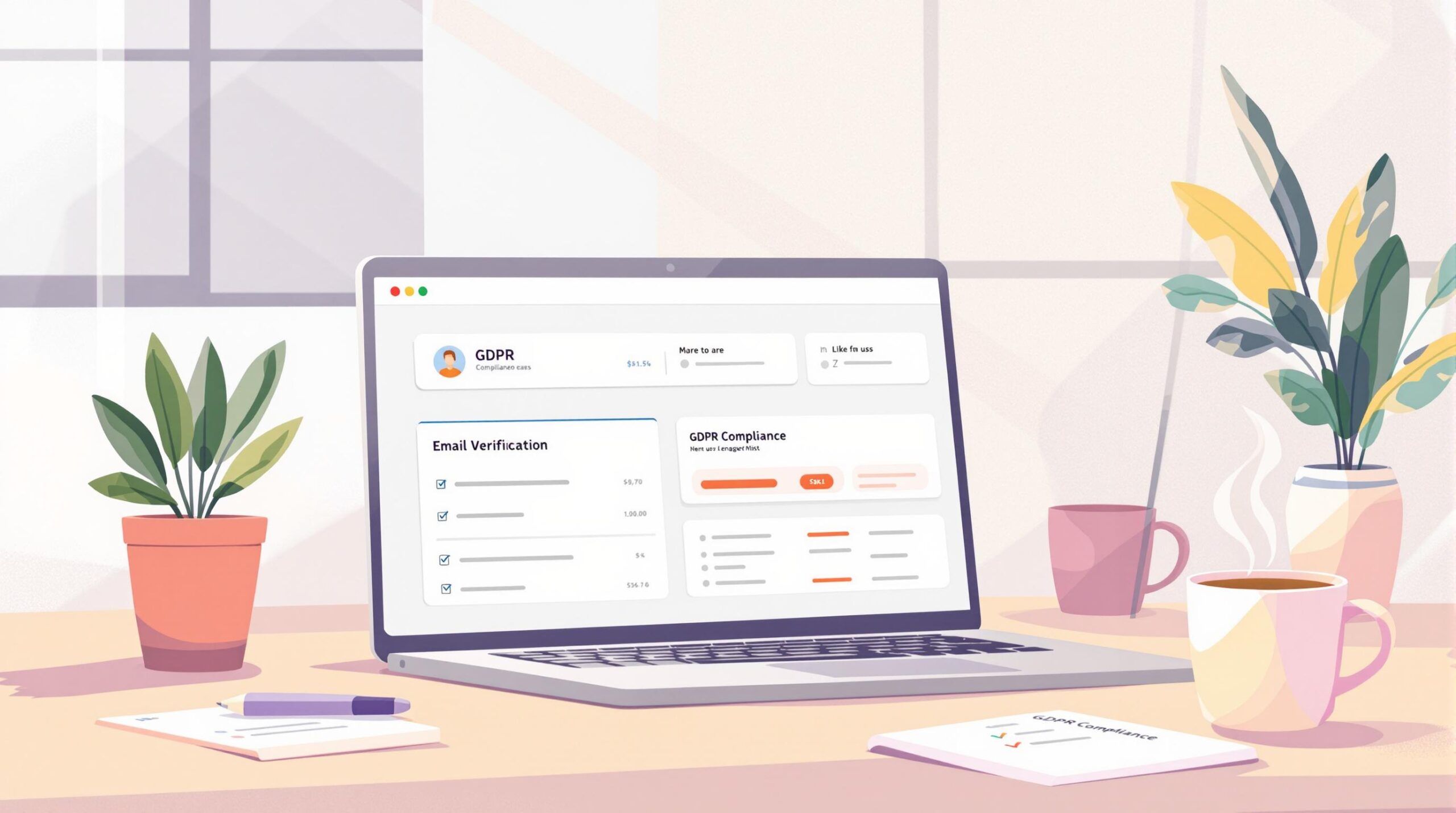- Double Opt-In: Always confirm user consent with a follow-up email.
- Clean Your Email List Regularly: Remove invalid and outdated emails to maintain data accuracy.
- Make Unsubscribing Easy: Provide a clear, one-click opt-out option in every email.
- Use GDPR-Compliant Tools: Pick tools like Bouncebuster that prioritize data privacy and accuracy.
- Verify Emails in Real-Time: Catch typos and fake addresses during data entry.
- Audit Your Processes: Regularly review consent records, email lists, and verification tools for compliance.
Why It Matters
GDPR requires businesses to handle email data responsibly, ensuring user consent, data accuracy, and privacy. Non-compliance risks include fines of up to €20 million or 4% of annual revenue. Following these tips not only avoids penalties but also builds trust with your audience.
Quick Tip: Investing in real-time verification tools and regular audits can simplify compliance while improving marketing efficiency.
GDPR compliance in Email Marketing: Step-by-step Checklist
Key GDPR Rules for Email Verification
Understanding GDPR’s main principles for email verification is essential for staying compliant and safeguarding user privacy.
Getting User Consent and Being Transparent
GDPR requires businesses to obtain clear and informed consent from users during email verification. This means:
- Consent must be actively given – no pre-checked boxes or vague terms allowed.
- Users should know exactly how their data will be used through clear and simple consent forms.
- Separate consent is needed for different purposes (e.g., newsletters vs. promotional emails).
Being upfront about how you collect and use data isn’t just about meeting legal standards – it also helps build trust and loyalty [1][3].
Once you’ve secured consent, the focus shifts to managing the data responsibly.
Ensuring Data Accuracy and Limiting Collection
GDPR stresses the importance of collecting only what’s necessary for email communication [1]. This approach helps businesses:
- Simplify data management
- Lower security risks
- Maintain higher-quality data
- Strengthen user trust
To comply with GDPR’s accuracy standards, businesses should regularly validate email addresses, correct errors quickly, remove inactive accounts, and use real-time verification tools during data collection [2][4].
Real-time tools ensure only valid email addresses are stored, which reduces bounce rates and improves email deliverability. Regular audits of email databases and verification processes also help maintain compliance [4].
6 Tips to Make Email Verification GDPR-Compliant
1. Clean Your Email List Regularly
Keeping your email list up-to-date is essential for GDPR compliance. Automated tools can help you remove invalid or outdated addresses, ensuring your data stays accurate. Plus, this practice protects your domain’s reputation and follows GDPR’s rule of keeping only necessary and accurate information.
2. Use Double Opt-In to Confirm Consent
Double opt-in is a must for proving user consent under GDPR. When someone signs up, send them a confirmation email asking them to verify their subscription. This extra step ensures only authorized signups make it to your list and creates a clear record of consent. Store these records securely to meet GDPR requirements.
3. Make Unsubscribing Easy and Clear
GDPR requires that users can withdraw consent without hassle. Include a simple unsubscribe link in every email. The process should be quick – ideally just one click – and shouldn’t require a login.
4. Choose GDPR-Compliant Tools Like Bouncebuster

Pick tools built with GDPR in mind. For example, Bouncebuster offers features like real-time email verification to help you stay compliant. Upcoming integrations with platforms like Mailchimp, Mailjet, and Salesforce will make managing your email lists even smoother while sticking to GDPR standards.
5. Verify Emails in Real Time
Real-time email verification catches typos and fake addresses at the point of entry. This reduces compliance risks by ensuring only valid data is collected.
"The importance of consent verification cannot be overstated. Every email address on your list must be there by choice, and GDPR mandates clear affirmative action from individuals before they can be contacted." – Věra Jourová, Vice-President for Values and Transparency [1][2]
6. Review and Audit Your Verification Processes
Regular audits are key to spotting and fixing compliance gaps. Set up a schedule to review your consent records, email list cleaning practices, and data handling procedures. Document these reviews to show your ongoing commitment to GDPR compliance and make adjustments as needed.
| Verification Process Component | Audit Frequency | Key Checks |
|---|---|---|
| Consent Records | Monthly | Consent timestamps and evidence |
| Email List Cleaning | Quarterly | Bounce rates, invalid addresses removed |
| Verification Tools | Semi-annually | Security updates, compliance features |
| User Opt-out Requests | Weekly | Processing speed, completion rate |
sbb-itb-f42cab2
How to Pick GDPR-Compliant Email Verification Tools
Selecting the right email verification tool is crucial for staying GDPR-compliant while managing your email lists effectively. The ideal tool should safeguard user data and simplify the verification process.
Key Features to Look For in Email Verification Tools
When assessing email verification tools, focus on features that balance compliance with efficiency. Prioritize tools that combine strong security with reliable verification options.
| Feature | Benefits for Your Business and Compliance |
|---|---|
| Real-time Verification | Enhances data accuracy and minimizes storage of invalid emails |
| API Integration | Automates tasks and simplifies compliance efforts |
| Bulk Verification | Keeps databases clean and accurate with regular updates |
| Audit Trail | Tracks verification history for compliance documentation |
| Security Protocols | Protects data and reduces the risk of breaches |
What Makes Bouncebuster a Good Option

Bouncebuster stands out by aligning with GDPR’s focus on data accuracy and privacy. Its REST API allows for smooth integration into existing systems, while its bulk verification feature ensures email lists stay up to date. Planned integrations with tools like Mailchimp, Mailjet, and Salesforce will make compliance even easier.
The platform caters to businesses of all sizes, offering tiered plans to meet growing email verification needs without compromising GDPR standards. Its real-time verification feature actively blocks invalid data entry, directly supporting GDPR’s requirement for accurate data management.
Research from Experian highlights that using proper email validation tools can greatly enhance data quality and boost customer engagement [4]. By choosing the right tools, businesses can tackle GDPR compliance challenges head-on while ensuring strong data protection practices.
Common Problems in GDPR Compliance and How to Solve Them
Many businesses encounter hurdles when trying to align their email verification processes with GDPR requirements. Here’s a closer look at the main issues and how to tackle them.
Misunderstandings About GDPR Rules
One frequent issue is confusion about how GDPR applies in practice. While earlier sections detailed its scope, businesses often struggle with day-to-day compliance, particularly around handling personal data and managing consent [5].
Since email addresses qualify as personal data under GDPR, companies must secure explicit, informed, and clear consent before processing them. Here’s how to address key compliance issues:
| Challenge | Solution | Impact |
|---|---|---|
| Grasping GDPR principles | Offer thorough staff training and consult experts | Promotes consistent compliance |
| Managing data effectively | Develop clear protocols and verification systems | Lowers risks and boosts accuracy |
Understanding the rules is just one part of the equation. Businesses must also tackle technical issues like verification errors.
Dealing with False Positives and Negatives
Verification errors can disrupt your email processes. False positives (valid emails marked invalid) risk losing real contacts, while false negatives (invalid emails marked valid) could lead to messaging non-consenting users, breaking GDPR rules [2].
To reduce these errors, consider these steps:
- Use advanced verification tools: Services like Bouncebuster offer real-time checks to filter out invalid emails right from the start.
- Adopt multi-layered processes: Regularly audit your database and use layered verification techniques to improve accuracy and stay compliant.
Conclusion: Aligning Email Verification with GDPR
Ensuring your email verification process aligns with GDPR isn’t just about following the rules – it’s about earning trust and safeguarding user privacy in today’s data-sensitive environment. The six tips shared earlier offer a practical guide to help you achieve this.
Striking the right balance between technical solutions and respecting user privacy is key. Here’s how businesses can align with GDPR effectively:
| Compliance Focus | Advantages |
|---|---|
| Real-time Verification | Minimizes invalid data and boosts email deliverability |
| Transparent Data Processing | Strengthens user trust and increases engagement |
| Regular Audits | Ensures data quality and lowers compliance risks |
Tools like Bouncebuster can simplify the process of meeting GDPR standards [2]. By prioritizing these areas and integrating tools with consent management and database upkeep, businesses can protect user privacy while achieving their goals.
Staying compliant also means keeping up with evolving GDPR requirements through constant monitoring and updates [1]. This dedication to data protection not only ensures legal adherence but also fosters stronger customer relationships by showing a commitment to privacy and transparency.



